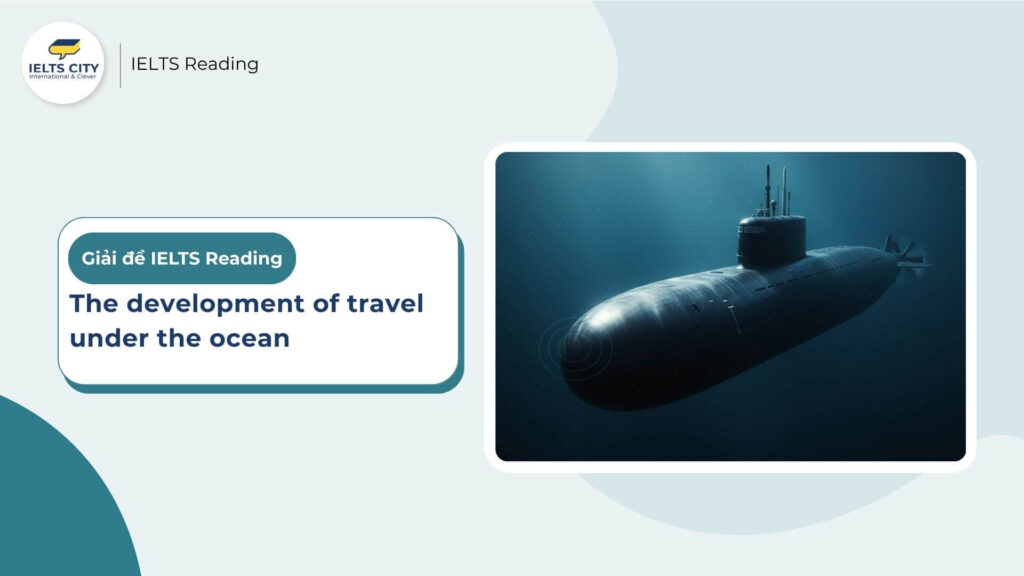
Nội dung chính
ToggleBài đọc
The development of travel under the ocean
For millennia, humans have been intrigued by what lies beneath the sea and although submarine travel was attempted from time to time, it did not become commonplace until the middle of last century. Several clever and innovative people had experimented with designs for submersible boats before then, but there was much loss of life and little success.
There had long been use of a primitive diving bell for exploratory purposes, but it was as a war machine that the submarine came into its own. The first development in the history of American submarines was a small submersible with a hand-cranked screw-like oar and a crew of one. It was built before the American Revolutionary War (1775—1783) but was adapted for use against the British during this war. Although its pilot twice failed to fasten explosive devices to British ships before losing control of his vessel, he escaped harm.
In 1800, an American inventor, Robert Fulton, designed an underwater machine that he called the Nautilus. This version brought in features that can still be found in some modern submarines, notably adjustable diving planes for better underwater manoeuvring, dual systems of propulsion, and a compressed air system that allowed it to stay down for about four hours without surfacing.
Development of submersible vessels lagged a long way behind the continued progress in the design of surface ships until the American Civil War (1861-1865) when both sides tried out various designs. One of those, called the Hunley — named after its financier rather than its inventor, sank twice during training missions with 11 crew members losing their lives including Hunley himself. Notwithstanding these failures, it was commissioned again in 1864 to attack a ship in Charleston Harbor. A torpedo was used to strike and scuttle the ship – a first in naval history, but the submarine never reappeared, and once again the whole crew perished. Its potential had been recognised, but there still remained the challenge of operating safely under the water.
The US Navy could appreciate the strategic benefits of having submarines in its fleet and held a competition to encourage design and construction of these underwater craft. The inventor, John Holland, won the competition and it was his sixth prototype, the Holland, that the navy bought and added to its fleet in 1900. This submarine was quite different from previous designs. It was propelled by a gasoline engine that turned a propeller while the vessel was on the surface. When it submerged, the engine ran a generator to charge batteries to operate an electric motor. The improved propulsion methods were, unfortunately, highly dangerous. Not only is gasoline flammable and unstable, using it in the restricted environment of a submarine posed quite a hazard for the crewmen. There was another problem, too: the batteries were not only heavy, cumbersome and inefficient, but they were also extremely volatile.
During the same period as Holland’s efforts were being trialled, a German scientist by the name of Rudolf Diesel created an engine which used a fuel less explosive than gasoline and which would consequently be stored safely. Another advantage was that there was no necessity for an electric spark to ignite the fuel. These safety improvements combined with better fuel economy allowed Diesel engines to power a submarine for longer on the surface; however, batteries were still needed to supply energy for underwater operation.
Although diesel-powered submarines were successful and used by the US Navy for almost 50 years, the search for a single power source carried on. It wasn’t long before the concept of nuclear power was realised in Germany and taken up by an American physicist, Ross Gunn, who could envisage its potential in submersibles. A research team was put together to adapt the concept of nuclear power for use in submarines. In effect, modern nuclear submarines have on board a small nuclear power plant which produces a great amount of energy. This is used to heat water and create steam which drives a huge turbine which turns the propeller.
There have been many adaptations and technological improvements made to submarines over the years, but the shape is basically the same. Obviously, it is a totally enclosed craft, cigar shaped with narrowed ends. The outer hull is the largest part of the boat and forms the body. The inner hull is designed to resist the considerable water pressure and insulates the crew from the cold. This is where the crew works, eats and sleeps. It also contains the engine room and the apparatus that makes clean air and clean water. Between the hulls are the ballast tanks for controlling buoyancy. There is a tall fin-shaped sail that comes up out of the hull. Inside the sail is the conning tower and extending from this, to the fore, there is a periscope (through which the captain can see the sea and sky when the submarine is near the surface of the water). Sonar is used for navigation deep below the surface. The other projection from the conning tower is the radio antenna.
Underwater, there are two controls for steering the submarine. The rudder (like a tail fin) controls side-to-side movement, and diving planes influence rise and descent. There are two sets of diving planes: the forward sailplanes and the stem planes, which are located at the back with the rudder and propeller.
Advancing technology will undoubtedly result in different shapes and modes of operation, and it is quite possible that, in the future, submarines will be manned by robots or computer technology that communicates information to land bases via satellite.
Kiến thức cần nắm:
Câu hỏi
Questions 1-6
Answer the questions below.
Choose NO MORE THAN THREE WORDS from the text for each answer.
Write your answers in boxes 1-6 on your answer sheet.
1. What kind of underwater device was used to investigate the ocean before submersible boats were invented?
2. What was the crewman of the first American-built submarine trying to do before his mission failed?
3. What gave the Nautilus the ability to remain submerged for a long time?
4. When was a submarine first used successfully to sink an enemy boat?
5. What new type of propulsion did the Holland use on top of the water?
6. For what reason was Diesel’s fuel considered safer than Holland’s?
Kiến thức cần nắm:
Questions 7-13
Label the diagram below.
Choose NO MORE THAN TWO WORDS from the text for each answer.
Write your answers in boxes 7-13 on your answer sheet.

7. ………………
8. ………………
9. ………………
10. ………………
11. ………………
12. ………………
13. ………………
Kiến thức cần nắm:
Đáp án kèm phân tích
Questions 1-6: Short Answer Questions
1. What kind of underwater device was used to investigate the ocean before submersible boats were invented?
- Đáp án: primitive diving bell (hoặc diving bell)
- Giải thích: Đoạn văn đề cập rằng trước khi tàu ngầm trở nên phổ biến, người ta đã sử dụng một thiết bị lặn thô sơ cho mục đích thám hiểm.
- Vị trí và trích dẫn: Đoạn 2, câu 1.”There had long been use of a primitive diving bell for exploratory purposes…”
2. What was the crewman of the first American-built submarine trying to do before his mission failed?
- Đáp án: fasten explosive devices
- Giải thích: Câu hỏi hỏi người lái tàu (crewman/pilot) đã cố làm gì trước khi thất bại. Bài đọc nói anh ta đã hai lần thất bại trong việc gắn thiết bị nổ vào tàu Anh.
- Vị trí và trích dẫn: Đoạn 2, câu 3.”Although its pilot twice failed to fasten explosive devices to British ships before losing control of his vessel…”
3. What gave the Nautilus the ability to remain submerged for a long time?
- Đáp án: compressed air system
- Giải thích: Câu hỏi hỏi tính năng nào giúp tàu Nautilus ở dưới nước lâu. Bài đọc liệt kê hệ thống khí nén cho phép nó ở dưới nước khoảng 4 giờ.
- Vị trí và trích dẫn: Đoạn 3, câu 2.”…and a compressed air system that allowed it to stay down for about four hours without surfacing.”
4. When was a submarine first used successfully to sink an enemy boat?
- Đáp án: 1864
- Giải thích: Bài đọc nói về tàu Hunley được tái biên chế vào năm 1864 để tấn công một con tàu và đó là lần đầu tiên trong lịch sử hải quân (a first in naval history) nó đánh chìm tàu địch bằng ngư lôi.
- Vị trí và trích dẫn: Đoạn 4, câu 3.”…it was commissioned again in 1864 to attack a ship in Charleston Harbor. A torpedo was used to strike and scuttle the ship – a first in naval history…”
5. What new type of propulsion did the Holland use on top of the water?
- Đáp án: gasoline engine
- Giải thích: Câu hỏi hỏi về loại động cơ đẩy (propulsion) khi tàu ở trên mặt nước (on top of the water/on the surface). Bài đọc nói nó được đẩy bằng động cơ xăng khi ở trên mặt nước.
- Vị trí và trích dẫn: Đoạn 5, câu 4.”It was propelled by a gasoline engine that turned a propeller while the vessel was on the surface.”
6. For what reason was Diesel’s fuel considered safer than Holland’s?
- Đáp án: less explosive
- Giải thích: Câu hỏi so sánh nhiên liệu của Diesel và Holland (xăng). Bài đọc nói Rudolf Diesel tạo ra động cơ dùng nhiên liệu “ít gây nổ hơn” (less explosive) so với xăng.
- Vị trí và trích dẫn: Đoạn 6, câu 1.”…Rudolf Diesel created an engine which used a fuel less explosive than gasoline…”
Đăng ký nhận tư vấn miễn phí
Ưu đãi học phí lên đến 40%
& Cơ hội nhận học bổng trị giá 2.000.000 VNĐ
Đăng ký nhận tư vấn miễn phí
Ưu đãi học phí lên đến 40%
________
Questions 7-13: Diagram labelling
7. forward sailplanes
- Giải thích: Mũi tên chỉ vào cánh ngang nằm trên tháp chỉ huy (sail). Đoạn 9 mô tả có hai bộ cánh lặn (diving planes), trong đó bộ phía trước gọi là “forward sailplanes”.
- Vị trí và trích dẫn: Đoạn 9, câu 3.”There are two sets of diving planes: the forward sailplanes and the stem planes…”
8. radio antenna
- Giải thích: Mũi tên chỉ vào cái ăng-ten dựng đứng phía sau kính tiềm vọng. Đoạn 8 nói vật nhô ra khác từ tháp chỉ huy là ăng-ten vô tuyến.
- Vị trí và trích dẫn: Đoạn 8, câu cuối.”The other projection from the conning tower is the radio antenna.”
9. periscope
- Giải thích: Mũi tên chỉ vào ống kính quan sát nhô lên cao nhất. Đoạn 8 mô tả nó mở rộng từ tháp chỉ huy, dùng để thuyền trưởng nhìn thấy biển và bầu trời.
- Vị trí và trích dẫn: Đoạn 8, câu 8.”…extending from this, to the fore, there is a periscope (through which the captain can see…)”
10. rudder
- Giải thích: Mũi tên chỉ vào cánh dọc ở đuôi tàu (giống vây cá). Đoạn 9 mô tả bánh lái (rudder) giống như vây đuôi, kiểm soát chuyển động sang hai bên.
- Vị trí và trích dẫn: Đoạn 9, câu 2.”The rudder (like a tail fin) controls side-to-side movement…”
11. propeller
- Giải thích: Mũi tên chỉ vào chân vịt ở đuôi tàu. Đoạn 7 và 9 đều nhắc đến chân vịt (propeller) dùng để đẩy tàu.
- Vị trí và trích dẫn: Đoạn 9, câu 3.”…located at the back with the rudder and propeller.”
12. stem planes
- Giải thích: Mũi tên chỉ vào cánh ngang ở đuôi tàu. Đoạn 9 gọi đây là “stem planes”, nằm ở phía sau cùng với bánh lái và chân vịt.
- Vị trí và trích dẫn: Đoạn 9, câu 3.”…and the stem planes, which are located at the back with the rudder and propeller.”
13. outer hull
- Giải thích: Mũi tên chỉ vào lớp vỏ bao bọc bên ngoài của thân tàu. Đoạn 8 nói lớp vỏ ngoài là phần lớn nhất và tạo nên thân tàu.
- Vị trí và trích dẫn: Đoạn 8, câu 3.”The outer hull is the largest part of the boat and forms the body.”
Cập nhật đề thi thật mới nhất tại:





















